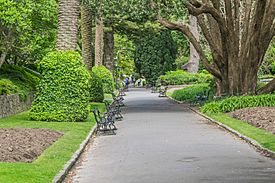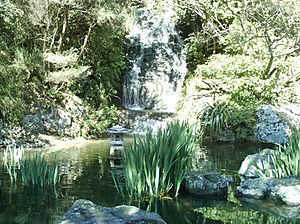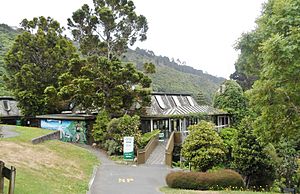Wellington Botanic Garden facts for kids
Quick facts for kids Wellington Botanic Garden |
|
|---|---|

A path in the Wellington Botanic Garden during spring
|
|
| Type | Municipal botanical garden |
| Location | Wellington, New Zealand |
| Area | 61.77 acres (25.00 ha) |
| Created | 1868 |
| Operated by | Wellington City Council |
| Status | Open all year |
The Wellington Botanic Garden is a fantastic park in Wellington, New Zealand. It covers a huge area of 25 hectares (that's about 60 acres!) on a hillside. You can find it between the Thorndon and Kelburn areas, very close to the city center.
This amazing garden is home to many different plants. It has protected native forests and special collections of trees and flowers. You'll also see beautiful seasonal displays that change throughout the year. The garden also features many plants from other parts of the world, like a large Rose Garden. It's even called a "Garden of National Significance" because it's so important!
The Wellington Cable Car is a fun way to get to the top of the Botanic Garden. It runs from Lambton Quay in the city up to the garden. Many people in Wellington love walking or jogging on the winding paths. Tourists also enjoy exploring the garden's many plant collections. It's a great downhill walk back to the city!
The Gardens have several cool spots to visit. There's a large Victorian-style glasshouse called the Begonia House. You can also explore the Lady Norwood Rose Garden and the Treehouse Visitor Centre. Kids love the big play area and the duck pond. On some nights, you might even see glowworms along the paths! The garden offers monthly tours to see them during autumn and spring. You'll also find many large sculptures and carvings by famous artists throughout the garden.
The Wellington City Council often holds fun events here. During spring and summer, you can enjoy free concerts at the Sound Shell.
The Wellington Botanic Garden is also home to a few important organizations:
- Carter Observatory, which is New Zealand's national observatory.
- The Wellington Cable Car Museum.
- The Meteorological Service of New Zealand, which studies the weather.

A Look Back: Garden History
The Wellington Botanic Garden first opened in 1868. It was first looked after by the New Zealand Institute, which later became the Royal Society Te Apārangi. James Hector was its manager until 1891. The New Zealand Institute planted many conifer trees. They wanted to see if these new plants could be useful for New Zealand's economy. In 1875, John Buchanan made the first map of the garden. He also listed all the plants growing there, including the native ones.
Before the Wellington Zoo opened in 1906, some animals lived at the Botanic Gardens. This included a special "City Emu." It moved to the zoo but sadly passed away soon after.
The Wellington City Council took over managing the garden in 1891. They helped develop many parts of the garden we see today:
- The Lady Norwood Rose Garden was created in 1950.
- The Begonia House was built in 1960.
- The Treehouse Visitor Centre opened in 1990. This was done with help from the World Wildlife Fund.
Explore More: Garden Gallery
See also
 In Spanish: Jardín botánico de Wellington para niños
In Spanish: Jardín botánico de Wellington para niños








